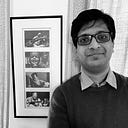Australian Open Tennis: what matters more in the second week — form or experience?
Seeding vs. Grand Slam success as a win predictor
The Trigger
This morning as the Australian Open Quarterfinal match between Gabine Muguruza (unseeded) and Anastasia Pavlyuchenkova (30)was about the begin, the broadcaster splashed its algorithm-based win probabilities — 50:50 was the verdict. Not only was the prediction not particularly useful, it was perplexing. For Pavlyuchenkova had never been past the Quarterfinals of any Grand Slam tournament, in five attempts. On the other hand Muguruza had won four out of 7 previous Grandslam QF encounters, and is a two-time Grand Slam winner. Surely in the second week of a Grand Slam, the GS track record had to count more than current form (as reflected in the seed of the player)? It did, Muguruza won, and Pavlyuchenkova choked at precisely the wrong moment in Set 1.
I decided to dig a little. I wanted to see what mattered more — (successful) GS experience or form. Further, as the greats of the game like Serena and Nadal eventually play less and less and begin to fade (I can’t bring myself to even speculate a Roger fade-away), can we expect to see form, as reflected in the seeding, to become a better win predictor vs. previous Grand Slam success?
I looked at the Round of 16 and QF results of the Australian open for the last 3 years (2018–20). For a measure of ‘experience’ or previous Grand Slam success, I came up with a crude points system — 4 for a title, 3 for a Finals appearance, 2 for Semis and 1 for QF.
I did not have any definitive hypothesis. I was hoping for some indication of experience being a better predictor than current form (seeds) and expected some signs of improved hit rates of seed-based predictions as the fields became more competitive.
The analysis is not and is not intended to be statistically valid, scientific or robust in any way (note that there are only 12 matches in each year’s consideration set, and often experience and seeding coincide). Merely indicative and fun.
The Verdict — Women’s Singles
Surprisingly seeds have remained a reasonably solid predictor of R16 winners in the last 3 years. Given the ‘wild west’ impression one gets of women’s tennis, I expected past GS experience, however limited, to have an outsized impact on the result of a match. This suggests the variation is more in how players move between seeds /ranks rather than in what players do once they are in a particular seed. (In musical terms, while there may be heavy gamaka movement between swara-sthanas, but the swara-sthanas are fixed).
Also given the theory — experience, and the habit and memory of winning that it brings, helps you play the big points better — I’d expect past success to not only be a better predictor, but also a stable one since human nature hasn’t changed. But it is stunningly variable in its efficacy as a predictor, and therefore wholly useless.
When we look at Quarterfinal results (only 4 matches each year, but I have a graph), the relative pattern between the two types of predictors remain the same.
There were only a handful of matches in each year (R16 and QF combined)in which the two methods offered conflicting predictions( three, five and four matches in 2018, ’19 and ’20 respectively). Which is a better predictor in these situations? Depends which year you ask. But given the discussion above, I’d go with seed, despite Muguruza beating Pavlyuchenkova.
The Verdict — Men’s Singles
Aah, as it should be. Experience matters.
Oh, until you get to the Quarterfinals.
Perhaps not surprisingly, given the amazing surge of the Rafa-Roger-Djoko Triumverate in the last years, there have been very few matches (R16 and QF) for which the two methods gave conflicting predictions (none in 2018, two in ’19 and three in ‘20). For what it’s worth:
Despite Zverev beating Wawrinka and Thiem dumping Nadal, I’m still inclined to go with Grand Slam experience as the better predictor. But that may have less to do with any of this number-crunching than not wanting to let go of the Triumverate Age.
Going further
It would be wonderful if some kind soul pulled all the GS data over the past several decades and did a more robust job of finding out which matters more in the second week of a Grand Slam — form or experience. The analysis can be fine tuned and improved upon in many ways (e.g. rank instead of seeds given Wimbledon’s seeding peculiarities, a measure of GS success particular to the round of the match in consideration, etc.). That would be lovely to see.
And here are data tables for your amusement.
Data Tables — Women’s Singles
Fun fact: Halep is the only player to make it to the Round of 16 in all three years.
Data Tables — Men’s Singles
Fun fact: This is the first time in three years that Rafa, Fed and Djoko feature in the Quarterfinals.
